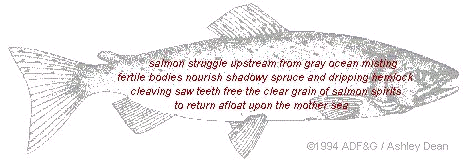


 |
Forest Cycles: "Our Boats are Made of Salmon"
|
 |
|
Our boats are part of a larger cycle of life. We will use this opportunity to increase our awareness of the resources we utilize, using science, drama, and Tlingit cultural traditions. We will harvest timber for our boats (at least a symbolic amount), and use that process to delve into forest ecology. Some parts of our boats will be sustainably harvested, some will not. There is a lesson in that contrast. Our boats, as they return to the ocean, are literally and metaphorically part of a much larger ecological process. Recent-breaking ecological research has demonstrated that a suprisingly large part of the nutrients in riparian vegetation, like the wood in our boats, literally swims in from the sea in the form of adult salmon bodies. (for a more detailed description of this research see: Fisheries, Feb. 2000) |
| This finding stems from high-tech ecological research, and is a very recent "newsworthy" development in our scientific understanding. The analysis machinery is complicated (mass spectrometry), but the story is not. The isotope ratios used in this discovery provide an excellent launching point for teaching about atoms ("the legos of our world") and molecules, of which we will construct models. The study of atoms (by the guys in the white lab coats), has radically altered our view of forest ecology (espoused by the scientists in the muddy hip boots). We will also use drama as a memory aid (see "atomic play") to help visualize atomic structure and isotopes. We will use our understanding of atomic structure and isotopes to help grasp the connections betweeen ocean and forests, and the "how" of what we know. Interestingly, this scientific understanding of the forest/ocean cycle has been embedded in ancient cultures like the Tlingits, for eons. |  |
Tlingit Tree harvest ceremony: In Tlingit culture, before a cedar was harvested for making a dugout canoe, a special ceremony was performed, wherein the tree was respectfully addressed, and animal skins were laid on the ground to soften the trees fall. We will study this ceremony, perform it or an appropriate adaptation, before harvesting our tree(s). We hope to interest a Tlingit elder in talking to us about the ceremony, or performing it with us.
Sawmill and Logging: We will visit a small sawmill, hopefully in conjunction with milling out our tree to rough sawn lumber, and visit with persons involved in logging. Our freshly milled lumber will be too wet and green for our purposes. We'll stick ours up to dry, and proceed with using identically dimensioned, but previously dried, lumber.
Cycles:
our boats are made from trees
trees are made from salmon
salmon swim upriver from the ocean
our boats go out to sea
Other References:
http://www.onrc.washington.edu/research/rfp/funded1997.htm#4
Robert Bilby's key paper on marine-derived nutrients: http://www.nrc.ca/cisti/journals/cjfas/f95-159.pdf
Back to: Boatbuilding: An Integrated Interdisciplinary Approach for the Elementary School Classroom
Contact: Fritz Funk (fritzf@alaska.net)